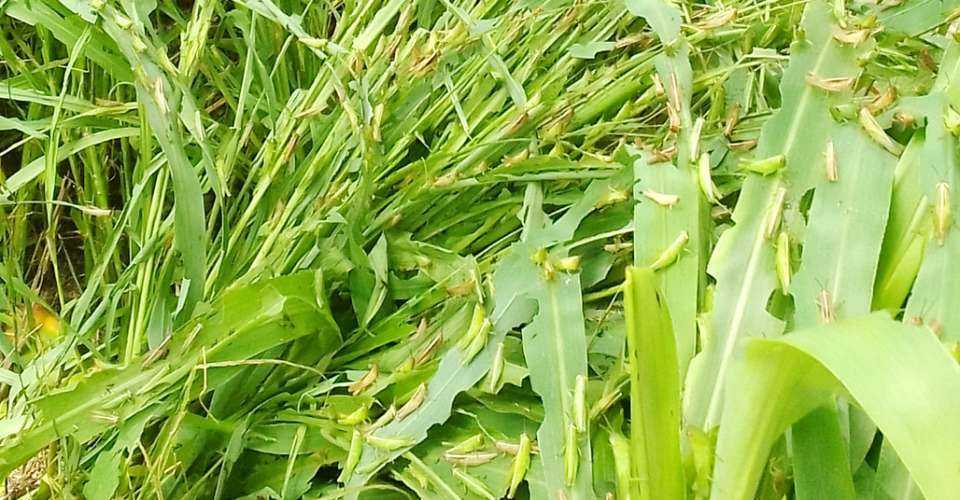
Locusts devour rice and corn in a field in Nghe An province in northern Vietnam on June 18. (Photo supplied)
Francis Xavier Tran Duc Quyen has been having sleepless nights since yellow-spined bamboo locusts started devouring crops in Nghe An province in north-central Vietnam about two weeks ago.
The 59-year-old farmer and father of three has been using traps with the help of his children to capture the locusts to stop them from feasting on his 1,500 square meters of rice and corn field, but in vain.
"Each night, using nets, kerosene lamps, and water, we catch around nine to 12 kilograms of locusts, but their numbers remain high as they continue to migrate from other areas,” Quyen told UCA News.
Quyen’s farmland sits amid about 10,000 square meters of neighbors' cropland, making it almost impossible to eradicate them.
"We've tried spraying insecticide, but it hasn't been effective due to the expansive nature of the fields and the rapid influx of locusts from neighboring areas," he said.
Hundreds of farmers like Quyen are facing similar challenges to save their crops and corn in up to 11 provinces including Nghe An where the locust infestation began on June 6, according to the Agriculture and Rural Development Ministry
It said in a statement last week that locusts have wreaked havoc on 1,031 hectares of forests and crops in the northern provinces of Nghe An, Bac Kan, Cao Bang, Dien Bien, Hoa Binh, Lang Son, Phu Tho, Quang Ninh, Son La, Thanh Hoa, and Tuyen Quang.
The ministry said that since late May, the locust outbreak had spread to seven additional provinces, increasing the affected area by about 400 hectares.
It said among the affected places, Cao Bang was the hardest-hit province where 773 hectares of crops were infested with locust swarms.
On June 6, the Cao Bang provincial People's Committee declared an emergency in the districts of Nguyen Binh, Hoa An, and Thach An.
Locust density in those districts have reached as high as 7,000-8,000 locusts per square meter.
Hoang Dao, 44, from Thach An district said the locust infestation has never been as severe and detrimental to crops as it is this year.
"Locusts appeared in our commune as early as late April. Despite efforts to spray insecticides, their effectiveness has been limited due to frequent heavy rain washing away the chemicals," the mother of two explained.
Dao said there is an overwhelming number of locusts, with new swarms continually emerging from the forests even after repeated spraying. Many households have applied insecticides up to 10 times, yet the locusts persist unabated.
Ho Thi Thuy Hang, 55, a farmer from Thanh Hoa province said that alternating patterns of sunshine and rain have not only helped locusts but fostered the rapid spread of pests like caterpillars and brown planthoppers, causing extensive damage to cropland.
Hang said locusts began wreaking havoc in the area last week, where they have decimated rice blossoms and gobbled young leaves of corn, pumpkin, and squash across more than 11 hectares of farmland. The infestation is now rapidly expanding to other areas.
She said local residents are actively using nets to trap and capture the locusts.
She recalled a devastating brown planthopper epidemic in 2020, which destroyed over 130 hectares of rice fields in her district, resulting in significant losses for numerous farming households.
"The extreme weather conditions leading to crop failures due to locust outbreaks, severely impact livelihoods and serve as a harbinger of potentially severe storms and floods in the coming months," she said.
"I have just 25 days left until I harvest my rice and corn. If I can't control the locusts, I stand to lose 15 million dong (US$600)," said Quyen, who uses a tricycle to transport building materials to make additional income.
He said that the locust infestation signals potential crop failures and hunger.
The ministry emphasized the importance of promptly implementing detection and control measures, noting that the nymphs will mature into adults within the next 10-20 days, posing a serious risk of substantial damage to a wide range of crops, and proving challenging to control.
Vietnam recorded locust swarms destroying around 4,000 hectares of forests and crops each year during the 2016-18 period. The severity of these infestations declined during 2019-2023.
In recent years, the yellow-spined locusts, known for their swift mobility and devastating impact, have also devastated forests and crops in China, Laos, and Vietnam.


